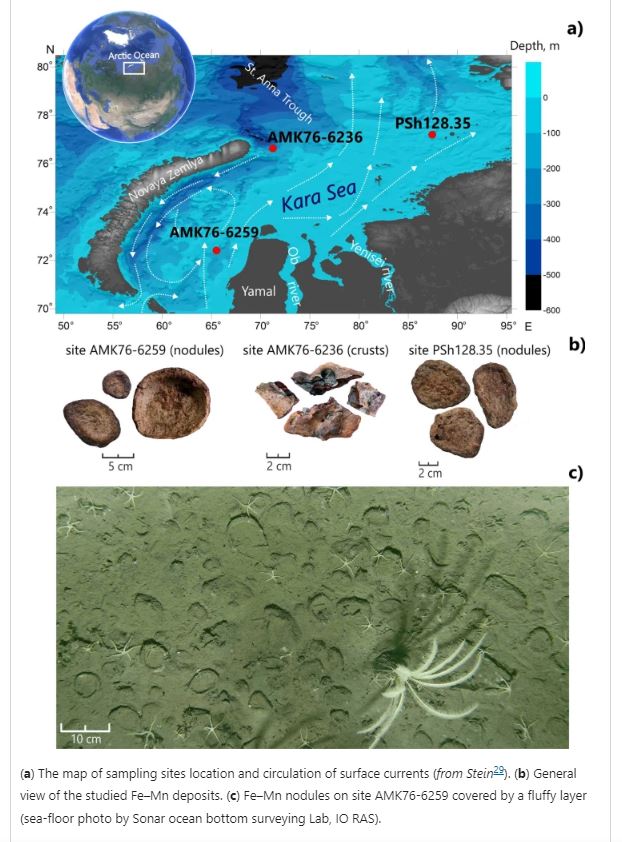March 14, 2023
Russian scientists have found out that ferromanganese nodules, or rounded mineral formations bedded in the Kara Sea shelf, are inhabited by unique microbial communities, which are probably accelerating the process of their formation. At the same time, the composition of microbial communities that use ferromanganese nodules as their habitat and "shelter" for protection from the harsh conditions of the Arctic seas largely depends on the chemical composition of the nodules. The results of the study, supported by a grant from the Russian Scientific Foundation (RSF), are published in the Scientific Reports journal.
The deposition of polymetallic ores in the World Ocean is a unique natural phenomenon. Among others, ferromanganese nodules, which are spherical mineral formations belong to this type ores. Ferromanganese nodules are enriched with metals necessary for a wide range of the latest high-tech and environmentally friendly energy developments. Nodules are considered a potential source of mineral raw materials. Their resources are estimated to be more than 300 billion tons. That said, the mechanisms of polymetallic ore deposition are a debatable topic in the scientific community. It remains obvious that their formation takes place in a system of complex interconnected chemical, physical and microbiological processes on the ocean floor.
 Vast accumulations of ferromanganese nodules have been encountered in the deep-water areas of the Pacific and Indian Oceans. Studies have shown that in these places the growth rate of ore depositions is millimetres per million years. At the same time, on the sea shelf, i.e., at much shallower depths, the formation and growth of nodules occur a thousand times faster. The scientists used the example of deep-sea nodules of the Pacific Ocean to show that microorganisms capable of oxidizing iron and manganese sedimentations in the formation of ferromanganese depositions, and the species composition of these populations can affect the growth rate of nodules. However, experts from different countries are just beginning to investigate this issue in detail.
Vast accumulations of ferromanganese nodules have been encountered in the deep-water areas of the Pacific and Indian Oceans. Studies have shown that in these places the growth rate of ore depositions is millimetres per million years. At the same time, on the sea shelf, i.e., at much shallower depths, the formation and growth of nodules occur a thousand times faster. The scientists used the example of deep-sea nodules of the Pacific Ocean to show that microorganisms capable of oxidizing iron and manganese sedimentations in the formation of ferromanganese depositions, and the species composition of these populations can affect the growth rate of nodules. However, experts from different countries are just beginning to investigate this issue in detail.
Scientists from the Institute of Oceanology of the Russian Academy of Sciences named after P.P. Shirshov (Moscow), the Institute of Microbiology of the Russian Academy of Sciences named after S.N. Vinogradsky (Moscow), the Institute of Geochemistry and Analytical Chemistry named after V.I. Vernadsky of RAS (Moscow) and foreign colleagues studied the structure, chemical composition and microbial communities in samples of ferromanganese nodules, formed on the Arctic shelf. The authors selected samples in three regions of the Kara Sea that differ in their conditions. Subject to the geographical location and hydrodynamic regime, iron or manganese compounds prevailed in the chemical composition of nodules. Having said that, the concentrations of these metals were comparable to those in deep-sea nodules that represent commercial value.
An analysis showed that extensive colonies of microorganisms in the form of rods and cocci (spherical cells) were present inside the nodules. The surface of the cells was covered with iron and manganese oxides that form a kind of shell. To determine the type of microorganisms, the authors isolated DNA from Arctic nodules for the first time and compared it with known genetic sequences in databases. It turned out that only 20% of the identified microorganisms were common to all the studied samples. Scientisits attributed these "cosmopolitans" to the Kiloniellaceae, Hyphomicrobiaceae and Pirellulaceae families. Representatives of Rhizobiales, Coxiellaceae and Cyclobacteriaceae that can oxidize iron were also widely distributed in iron-rich sediments. The manganese-enriched nodules were mainly inhabited by those families that can use manganese for energy production - Magnetospiraceae, Scalinduaceae and Woeseiaceae. The processes of formation of the porous matrix of ferromanganese nodules can accelerate owing to these very microbial families, which are partly unique for each of the studied samples.
"We have demonstrated that a favourable environment is created in the Arctic conditions inside ferromanganese nodules for the vital functioning of microorganisms that restore, oxidize or accumulate metals in themselves. In such "shelters", the metabolic activeness of microorganisms contributes to the accelerated growth of ferromanganese nodules. Further comprehensive study of Arctic nodules will help understand the processes of offshore ore genesis and global biogeochemical cycles," - said project manager Natalia Shulga, Candidate of Geological and Mineralogical Sciences, Senior Researcher at the Laboratory of Ocean Chemistry of the Institute of Oceanology of the Russian Academy of Sciences named after P.P. Shirshov.
Sources:
https://www.nature.com/articles/s41598-022-23449-6
Translated by Muhiddin Ganiev